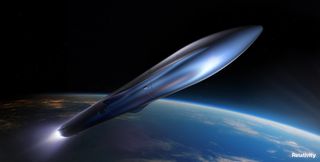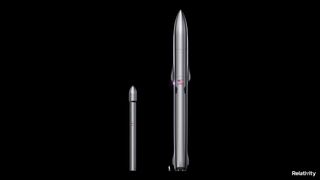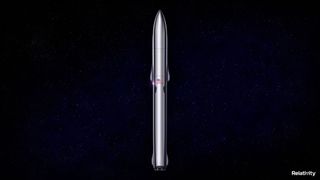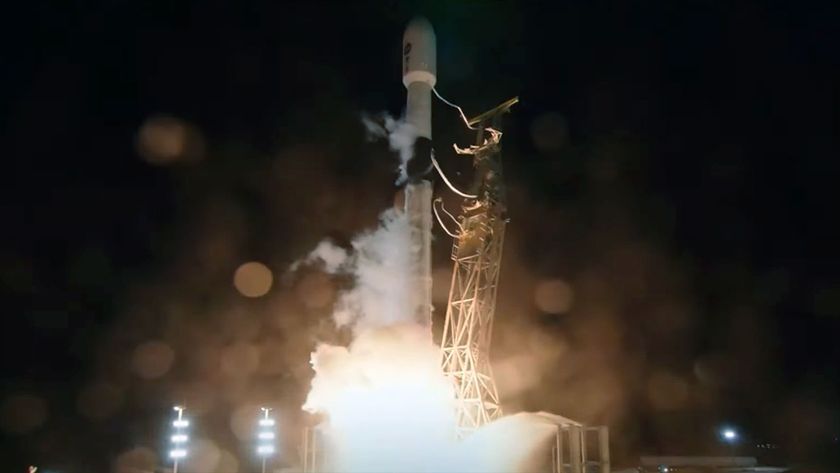A fully reusable, 3D-printed rocket will be launching satellites to orbit three years from now, if all goes according to plan.
Today (June 8), Relativity Space revealed details of Terran R, a new two-stage rocket that's key to the Southern California startup's bold off-Earth goals, which include helping humanity get a foothold on Mars.
"Terran R is at the cutting edge of rocket innovation and design," Zach Dunn, senior vice president of engineering and manufacturing at Relativity Space, said in a statement. "Fully reusable and entirely 3D printed, Terran R will be well suited to serve customers' evolving needs in the large satellite constellation industry, while also representing a significant leap towards achieving our mission of building humanity's industrial base off of Earth."
Related: Relativity Space will 3D-print rockets at new autonomous factory

Terran R will be a big step up in power and performance from the two-stage Terran 1, an expendable rocket that Relativity Space expects to start flying later this year. Nine different customers have already signed contracts to put payloads on Terran 1, company representatives said.
Terran 1 is 115 feet (35 meters) tall by 7.5 feet (2.3 m) wide and can deliver a maximum of 2,756 lbs. (1,250 kilograms) to low Earth orbit (LEO), according to its specifications page. The vehicle's first stage is powered by nine of Relativity Space's Aeon 1 engines, while the upper stage features one vacuum-optimized Aeon.
The engines, which burn liquid oxygen and methane, are 3D printed, just like the rest of the rocket. This manufacturing strategy allows Relativity Space to build rockets with 100 times fewer parts than those of its competitors and churn out a completed vehicle in less than 60 days, company representatives said.
Get the Space.com Newsletter
Breaking space news, the latest updates on rocket launches, skywatching events and more!

Terran R is expected to launch for the first time in 2024. Like Terran 1, it will depart from a pad at Cape Canaveral Space Force Station, on Florida's Atlantic Coast.
Terran R will be 216 feet (66 m) tall by 16 feet (4.9 m) wide, with the ability to loft more than 44,100 lbs. (20,000 kg) to LEO, Relativity Space representatives said. The rocket's first stage will be powered by seven Aeon R engines, a brawny, high-pressure cousin of the Aeon 1. Terran R's upper stage will feature one vacuum Aeon, as on Terran 1.
Terran R's payload capacity is close to that of SpaceX's workhorse Falcon 9, a pioneer in rocket reuse. Falcon 9 first stages regularly and repeatedly come back to Earth after sending satellites on their way to orbit; last month, for example, a Falcon 9 booster known as B1051 launched and landed for a record 10th time.
But Relativity Space, which was founded in 2015, aims to take reuse a step further with Terran R. The entire rocket — the first stage, the second stage and the payload fairing, which protects satellites during launch — will be reusable, company representatives said.
"There’s an organic relationship between 3D printing and reusability, and it gives us an unparalleled advantage to design the best fully reusable rocket possible," Relativity Space co-founder and CEO Tim Ellis said in the same statement.
Terran R has been in Relativity Space's plans for a while, but the company decided over the past year or so to accelerate its development. That work will be aided by an infusion of investor cash — $650 million in newly secured equity funding, the company announced today.
Such a haul is not exactly unprecedented for Relativity Space. The company raked in $500 million in its previous investment round, which was announced in November 2020.

"Relativity was founded with the mission to 3D-print entire rockets and build humanity’s industrial base on Mars," Ellis said.
"We were inspired to make this vision a reality, and believe there needs to be dozens to hundreds of companies working to build humanity’s multiplanetary future on Mars," he added. "Scalable, autonomous 3D printing is inevitably required to thrive on Mars, and Terran R is the second product step in a long-term journey Relativity is planning ahead."
Though today marked Terran R's official unveiling, the rocket's existence was not a secret: In February, CNBC's Michael Sheetz wrote an in-depth story about the vehicle and its envisioned role.
Mike Wall is the author of "Out There" (Grand Central Publishing, 2018; illustrated by Karl Tate), a book about the search for alien life. Follow him on Twitter @michaeldwall. Follow us on Twitter @Spacedotcom or Facebook.
Join our Space Forums to keep talking space on the latest missions, night sky and more! And if you have a news tip, correction or comment, let us know at: community@space.com.

Michael Wall is a Senior Space Writer with Space.com and joined the team in 2010. He primarily covers exoplanets, spaceflight and military space, but has been known to dabble in the space art beat. His book about the search for alien life, "Out There," was published on Nov. 13, 2018. Before becoming a science writer, Michael worked as a herpetologist and wildlife biologist. He has a Ph.D. in evolutionary biology from the University of Sydney, Australia, a bachelor's degree from the University of Arizona, and a graduate certificate in science writing from the University of California, Santa Cruz. To find out what his latest project is, you can follow Michael on Twitter.










